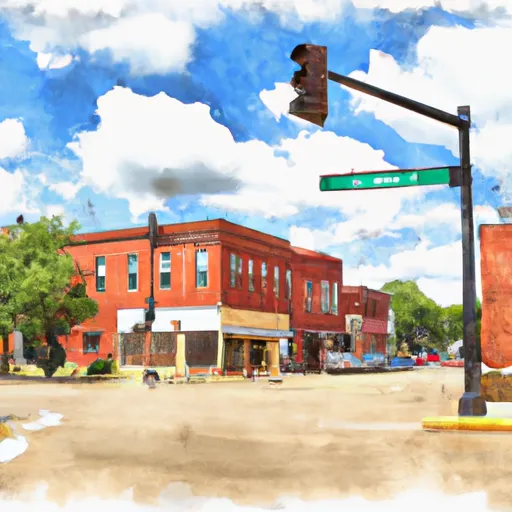-
 Snoflo Premium
Snoflo Premium
Get unlimited access to all our content
With no Ad interruptions! - Start Your Free Trial Login with existing account
Cairo
Eden Index
Climate
8.3
•
Recreation
3.1
•
Community
1.4
•
Safeguard
4.7/10

Cairo, Missouri is a small town located in the northern part of the state. The climate in Cairo is characterized by hot summers and cold winters, with precipitation occurring year-round. The town is situated near the Mississippi River and has access to several tributaries, making hydrology an important aspect of life in the area. Outdoor recreation opportunities include fishing, boating, and hunting, with several state parks and conservation areas located nearby. The hydrology constituents in the area include sediment and nutrient runoff from agricultural fields, which can impact water quality in the Mississippi River. Despite these challenges, Cairo remains a charming town for outdoor enthusiasts to explore.
What is the Eden Index?
The Snoflo Eden Index serves as a comprehensive rating system for regions, evaluating their desirability through a holistic assessment of climate health, outdoor recreation opportunities, and natural disaster risk, acknowledging the profound impact of these factors on livability and well-being.
Climate Health Indicator (CHI): 8.3
Cairo receives approximately
1032mm of rain per year,
with humidity levels near 82%
and air temperatures averaging around
12°C.
Cairo has a plant hardyness factor of
6, meaning
plants and agriculture in this region thrive during a short period during spring and early summer. Most
plants will die off during the colder winter months.
By considering the ideal temperature range, reliable water supplies, clean air, and stable seasonal rain or snowpacks, the Climate Health Indicator (CHI) underscores the significance of a healthy climate as the foundation for quality living.
A healthy climate is paramount for ensuring a high quality of life and livability in a region, fostering both physical well-being and environmental harmony. This can be characterized by ideal temperatures, reliable access to water supplies, clean air, and consistent seasonal rain or snowpacks.
Weather Forecast
Streamflow Conditions
Upper Mississippi-Salt
Area Rivers
Upper Mississippi-Salt
Snowpack Depths
Upper Mississippi-Salt
Reservoir Storage Capacity
Upper Mississippi-Salt
Groundwater Levels
Recreational Opportunity Index (ROI): 3.1
The Recreational Opportunity Index (ROI) recognizes the value of outdoor recreational options, such as parks, hiking trails, camping sites, and fishing spots, while acknowledging that climate plays a pivotal role in ensuring the comfort and consistency of these experiences.
Access to outdoor recreational opportunities, encompassing activities such as parks, hiking, camping, and fishing, is crucial for overall well-being, and the climate plays a pivotal role in enabling and enhancing these experiences, ensuring that individuals can engage in nature-based activities comfortably and consistently.
Camping Areas
| Campground | Campsites | Reservations | Toilets | Showers | Elevation |
|---|---|---|---|---|---|
| Camp Robinson RV Military | None | 512 ft | |||
| Rush Landing - Buffalo National River | None | 451 ft | |||
| Buffalo Point - Buffalo National River | None | 535 ft | |||
| Quarry Cove - Norfolk Lake | None | 628 ft | |||
| Maumelle | None | 281 ft | |||
| Downtown Riverside RV Park | 69 | 250 ft | |||
| Burns Park | 38 | 280 ft | |||
| Toad Suck Ferry | None | 274 ft | |||
| Barkshed | 6 | 559 ft | |||
| Woolly Hollow State Park | None | 483 ft |
Nearby Ski Areas
Catastrophe Safeguard Index (CSI):
The Catastrophe Safeguard Index (CSI) recognizes that natural disaster risk, encompassing floods, fires, hurricanes, and tornadoes, can drastically affect safety and the overall appeal of an area.
The level of natural disaster risk in a region significantly affects safety and the overall livability, with climate change amplifying these risks by potentially increasing the frequency and intensity of events like floods, fires, hurricanes, and tornadoes, thereby posing substantial challenges to community resilience and well-being.
Community Resilience Indicator (CRI): 1.4
The Community Resilience Indicator (CRI) recognizes that education, healthcare, and socioeconomics are crucial to the well-being of a region. The CRI acknowledges the profound impact of these elements on residents' overall quality of life. By evaluating educational resources, healthcare accessibility, and economic inclusivity, the index captures the essential aspects that contribute to a thriving community, fostering resident satisfaction, equity, and social cohesion.

